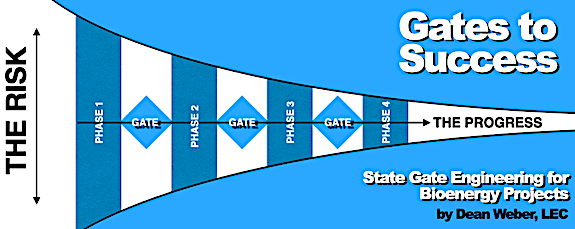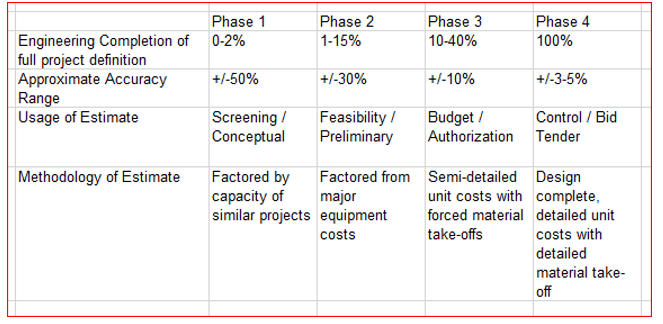Gates to Success: Stage Gate Engineering for Bioenergy Projects

By Dean Weber, Lee Enterprise Consulting
Special to The Digest
The status of the bioenergy industry can change rapidly due to numerous factors, including technological advancements, policy changes, and market dynamics. These all create risks for investors and stakeholders. While rapid deployment of investments is critical to beat the competition, we still need to allocate based on ‘certainty of outcome’ for the defined and agreed upon project goals. Thus, it is necessary that all stakeholders are aligned to the certainty of scope, schedule, and budget – meaning that for bioenergy projects a good planning and execution strategy is essential. When such projects fail it is typically for one or more of the following reasons:
- Stakeholders (owners, clients, engineering, and construction firms) are not aligned on project goals.
- Stakeholders do not fully understand what it takes to execute a large capital project.
- Decisions are stated, but not always documented, leading to differing interpretations or lack of understanding. (In these cases, a successful project for one stakeholder can be considered a failure for another, or sometimes even a failure for all.)
It is in our best interest to minimize these issues by developing the project with a proven process called stage gate engineering to reduce investment risks and reduce or ensure project budgets and schedules for bioenergy projects.
Stage Gate Engineering
Stage gate engineering is a project management and decision-making framework that is commonly used in a variety of industries, including bioenergy, to guide and evaluate projects through stages of development. In bioenergy projects, the stage gate process typically involves key phases consistent across the industry. While different companies may use different names and groupings, they are generally the same and have the same intent – to ensure projects are successful and meet the goals of all stakeholders.
Construction is not the time to figure out the plan. I have been called, to assist with recovery of a project, into ‘daily take-out meetings’ (yes, that was what they were called) with a Fortune 100 company during construction of a major facility to demolish work installed the day before and change designs on the fly because of poor early project planning. This is where construction firms have their little dingy boat named ‘PO’ and the big yacht named ‘Change Order.’
Diagram 1 provides a simple representation of the stages for engineering development. In this case, I use four gates (or “phases”) for engineering development; some companies may have fewer or more stages with varying development of deliverables for each phase:

Diagram 1 – Example of Stage Gate estimate accuracy based on engineering completion.
Fees
Typical industrial bioenergy projects may range from 5-16% engineering fee as compared to total installed costs. For ease of this example, let’s consider the total engineering for the project is 10% of the Total Installed Cost (“TIC”). Demonstrated and well-defined processes or processes with exceedingly high equipment capital costs may be lower; new-to-world processes are typically higher.
Engineering fees can be hidden in vendor equipment costs, lump sum construction, “EPC” (Engineering, Procurement, and Construction) costs, etc. so when comparing engineering costs from engineering firms vs EPC firms, it is important to be cognizant that EPC companies may lump engineering fees into other buckets and say the project can be done with less engineering costs; often they are moving the money around accounts and making the project cost up elsewhere. EPC project budgets can very easily have high engineering costs buried in subcontracts for vendor equipment.
Note that the real goal of each phase is to better define the scope and schedule to get to a related range of accuracy for a cost estimate, which should be better at the end of each phase. Let us dig into this a bit further by defining further what each stage means. We will first look at definitions of the phases and what they provide. This article will not delve into specific deliverables for each phase as that is a much more detailed conversation. But do understand that deliverables are first developed into preliminary, then detailed, then final deliverables through the process. Examples of deliverables, for which there may be hundreds in any given project, include P&IDs, General Arrangements, etc.
Author’s Key Learning Experience #1
It is cheap to make changes early in the design and planning of a project but when detailed engineering design and construction starts, the money flows rapidly and changes become costly. Making a solid plan early, before engaging an army for detailed engineering and construction, saves time and money and helps ensure success.

The Gates and Phases
Gate 1/Phase 1: Screening/Conceptual Estimate
There are a lot of bioenergy startup companies that identify a goal in this phase and go straight to buying equipment and starting construction. Unfortunately, this can generate excessive risk, uncertainty of outcome, and inability to adjust effectively as you go forward.
In the gated process, we will make a screening/conceptual goal and spend about 1% of the total anticipated total engineering fee. This nominal effort using the gate-specific deliverables list can provide a cost estimate in the +/-50% range. For 0.1% of the TIC of the project you get a significant impact and understanding of the risks and costs for little effort and cost. By developing a scope for the project and using similar historical facility costs we can see if the project looks positive from an investment standpoint. If the goals hold up and the preliminarily defined scope, schedule, and budget meet all shareholder goals we move to Gate 2. If at the end of stage 1, goals do not match up to make a successful project, either the project can be closed with little wasted and before greater investment is made on a likely failed effort, or risks to the project can be mitigated by adjusting the scope, schedule, and budget in order to move forward in a better-defined direction. It is imperative to refrain from moving forward until stakeholders are aligned at each gate or money and time will be wasted.
It is also imperative that the ‘+’50% estimate be the number used at this point to realize the total risk at this point. The +/-50% estimate is based on a bell curve. It is an outcome, but it is still a wide range at this point. Decisions should be made as to how to proceed based on the whole bell curve and not just the center or – as I have seen many times, a substantially lower number. While this might result in getting a project approved, it never goes well when the ultimate project cost far exceeds the estimate.
Gate 2/Phase 2: Feasibility/Preliminary Design/Options Analysis
In this phase, typically, about 10% of the overall engineering fee is expended, or just 1% of the anticipated TIC. See how efficiently money is spent doing a stage gate approach? We can develop the scope, schedule, and budget to a point where we can increase our cost estimate accuracy to approximately +/-30%. Again, that ‘+’30% number needs to be considered as most risks are starting to be understood and the number rarely goes down in a project estimate, even with the best intent.
This is the time to review and select alternative designs, and define financial and technical risks, and assign mitigation strategies.
By assembling major equipment quotes, we can use industry-standard metrics to better understand costs based on the final scope and findings from the approved Gate 1. Note there is an estimating tool called the Lang Factor based on historical data of many industrial projects. For bioenergy and industrial projects, this is cast in the 3-5.5 range and should be specified by a trained estimator. In this case, if we use 4, we will take the major equipment costs x 4 to get to our TIC estimate. It is imperative that someone trained in estimating and use of historical data do this estimate and confirm historical Lang Factors for ‘major equipment.’ A Lang Factor of 4 or 5 may seem extravagant, but most people do not consider all the things that need to be done to get a facility designed, built, and operating. Too many times, I have seen a client rely on major equipment costs plus the old ‘times 2’ math – only to find a failed and over-budget project later.
It is important to note that the Lang Factor is a quick and rough estimation tool. It is not suitable for detailed project cost estimates or for use in project financing decisions. As the project progresses and more detailed engineering and design work are conducted, more accurate and comprehensive cost estimates are typically developed.
At this stage, drawings will typically be IFR (issued for review).
Author’s Key Learning Experience #2
Risk mitigation is crucial. It is important early on during project development to assemble and regularly review a list of risks, estimate the likelihood and cost of each risk, and then develop a mitigation strategy for each.
Author’s Key Learning Experience #3
Scope = budget. Project costs don’t magically go down; scope must be reduced to reduce the budget. That fancy office building/viewing area with an elevator over the process is usually the first to get cut.
Gate 3/Phase 3: Budget/Authorization
Now that we have developed a good basis, understanding through documentation, and alignment of all stakeholders that they agree that the project is still rational at Stage 2, we can move to Stage 3. This is where the real ‘basis of design’ is developed, and the engineering effort proceeds to about 30% of total engineering (about 3% of the anticipated TIC budget). In this phase, an astounding amount of progress is made in defining the project and preparing for detailed engineering (Gate 4), which is the brunt of the effort. Do you see how we are doing fundamental planning work first before engaging an entire army of engineers and constructors?
This stage is where real general arrangement work is undertaken, as well as preliminary P&ID development so that take-off estimates can be pulled together. Long-lead equipment engineering is likely underway, and based on semi-detailed unit costs and some forced material take-offs, an estimate can now be developed to an approximate +/-10% range, which makes it an appropriate time to request full funding for the overall project and long-lead items. At this stage, drawings will be IFD (issued for Design).
Author’s Key Learning Experience #4
As projects are developed certain areas may become very well understood and defined while some others need further definition. Using the Phase 3 estimate is a suitable time to do a range analysis by project area. For example, say that receiving is well understood and is determined to have 5% accuracy range while something like a unit operation in processing is less understood and may have a 15% range of accuracy. Overall, at this stage, we should get to about 10% accuracy and have mitigation strategies in place for those higher-range accuracy areas.
Gate 4/Phase 4: Control Bid/Tender
At this stage, money flows out in a hurry, not as fast as during actual construction but some early works may be starting now for site work and longer lead equipment orders may be beginning to flow. In this stage, the entire design team, vendors, and hopefully constructors are engaged in executing the final design of the project. Designs will be IFC (issued for construction). At this stage, the bulk of the engineering funds are expended, about 70% (7% of TIC) so having a good design basis from Phase 3 is imperative.
If approved at the end of Stage 3, we have fully approved funding from lenders or owners and are off to the races for final design, all equipment orders, and construction activities.
It should be noted that a completely designed and costed project still has a range of accuracy of 3-5%. There are just too many factors to consider during construction. Finance must take this variability into account when planning for project budget requirements.
Author’s Key Learning Experience #5
The most successful projects have an execution strategy identified in the initial project stages and constructors are engaged as early as possible so that engineering and construction teams are working in unison to identify designs that may cost more or help provide construction input to enhance the project.
Summary
At each stage, a gate review is conducted to evaluate the project’s progress and determine whether it should proceed to the next stage. The decision to move forward should be based on predefined criteria, which can include capacity, technical, financial, environmental, and market-related factors.
It may surprise you but many projects end, and should end, in preliminary stages as costs and risks become more defined and make project success an unreasonable expectation. For those projects that get canceled, one should consider oneself lucky that things didn’t proceed and money did not get wasted on a project that really had no legs anyway. For those projects that continue to gain approval from stakeholders, a better success rate is ensured by following industry-proven steps during project development.
The outcome of executing a bioenergy project using the stage gate process is a well-defined project with all stakeholders aligned to the project definition of scope, schedule, and budget with the ability to change direction as the project details become more understood and mitigate costs and risks at each stage well before major money is spent on hard assets that may not align with the understanding of all stakeholders.
There is a misunderstanding sometimes that this process slows down the project schedule; it is well documented by the (CII) Construction Industry Institute that using a staged approach reduces costs and schedules for major capital projects.
Stage gate engineering helps ensure that resources are allocated effectively, risks are managed, and project objectives (scope, schedule, and budget) are met. It also provides a structured approach to decision-making, allowing stakeholders to make informed choices about the continuation of the project at each gate. This framework is essential for managing complex and capital-intensive bioenergy projects to maximize their chances of success.
About the Author
Dean Weber, has over 35 years of experience and technical expertise in the early development of strategically complex projects, including strong project management and the ability to lead successful design teams for Front End Engineering and Design, as well as scale-up for commercial facilities including process engineering services, bio-industrial, food, wastewater, oilseed processing, anaerobic digestion, and process safety management. He serves as a Project Director at Lee Enterprises Consulting, overseeing matters involving Bio-Process Engineering Services, Food, Wastewater, Oilseed Processing, Anaerobic Digestion, Process Safety Management.
About Lee Enterprises Consulting
Lee Enterprises Consulting has over 180 experts that can help navigate your bioeconomy needs. If you need assistance with your Bioenergy project(s), please Contact Us.
Category: Thought Leadership, Top Stories















